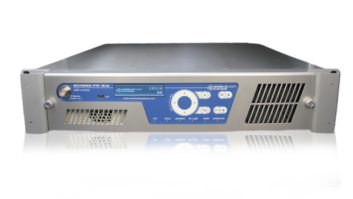(click thumbnail)Fig. 1: Keep a log of the meters on your generator.
(click thumbnail)Fig. 2: This external fuel filter is in addition to the fuel filter installed on the generator engine.
(click thumbnail)Fig. 3: You routinely replace transmitter air filters; do the same with generator filters. Given the catastrophic calamities experienced by engineers over the past couple of years, reliable backup systems have become “top of mind” matters.
Backups don’t have to be fancy, just reliable. Only through routine maintenance can you be assured of a trustworthy system. Nowhere is this truer than with a backup power system. Generators are engines that must be tested, preferably under load.
Just as it’s easier to troubleshoot a transmitter with routine logged parameters, the same is true with the generator. Keep a log of the front-panel meters, as seen in Fig. 1. Many of the newer gensets have remote annunciators that can be tied to your remote control. These warning indicators can give you an early “heads up” to developing problems. especially if you can’t get to the site regularly.
Filtering the diesel fuel is another small step that will pay back tremendous dividends. Fig. 2 shows an external fuel filter that was added to this generator. This filter is in addition to the fuel filter already installed on the generator engine.
You routinely replace transmitter air filters, such as those shown in Fig. 3. Regular replacement of fuel, oil and air filters is just as important on a generator.
(click thumbnail)Fig. 4: As you inspect the generator body, search for leaks, especially around filters and engine seals.
(click thumbnail)Fig. 5: Pretend it’s a car: inspect battery cables, remove corrosion from the terminals, tighten connections.
(click thumbnail)Fig. 6: A bad connection can mean an engine that will not start.
As you inspect the generator body, search for leaks, especially around filters and engine seals such as those seen in Fig. 4. Remember, leaks won’t correct themselves, and usually just get worse. The stresses a generator operates under when fully loaded will push a marginal component to the breaking point. Your job is to find that weakest link.
Walt Billings, president of Total Engine Service and Supply in Baltimore ( www.comm-struction.net ), a generator, power distribution and control systems contractor, says broadcast engineers can conduct several tests themselves. Over the years, his firm has supported SBE chapters with auxiliary power maintenance programs.
Fluid levels are important, just as in your car. Walt receives no end of service calls when the weather gets cold and utility power fails. Many are due to corroded battery terminals.
Pretend you are checking your car: i.e., inspect the battery cables, remove corrosion from the terminals and make sure the connections are tight. If the batteries are not sealed, check and replace the level of distilled water.
Where you see wire connections, test them for tightness, frayed or broken wires or insulation and corroded terminals.
According to Billings, coolant level and brittle hoses are two areas that are often overlooked. Although the problem has been corrected on most state-of-the-art generators, older units may not have auto shutdown systems that are triggered on low coolant or high temperature. These conditions can occur when a coolant hose bursts. If you’re not there to catch the problem, you’ve just cooked an engine and your supply of backup electricity.
Inspect hoses for cracks and stiffness. If, when squeezing the hose, you see small cracks in the surface, it’s time for replacement. Coolant hoses should have some “give” when squeezed. Remember some hoses are reinforced with an inner spring to prevent collapsing and may not “give” as easily. If the hose looks suspicious, replace it. Periodically check the coolant level as well.
Most manufacturers recommend a complete generator shutdown once every 24 to 48 hours of continuous service. During this brief shutdown, check all fluids and replenish them as needed. This is a good time to check for leaks. In fact, after a test cycle, as the generator cools down, use a flashlight to inspect the generator. Vibration may have loosened hardware, broken wires or chafed hoses.
While we’re on the generator theme, here’s some neat training news.
Generac, a generator manufacturer in Eagle, Wis., has completed construction on a 6,000-square-foot Technical Training Center. In addition to providing training and troubleshooting on a variety of products, the company has developed a “Second Chance” youth apprenticeship program.
This vocational opportunity combines training at the Generac facility with an on-site classroom experience. The program offers credit-deficient high school students who have difficulty thriving in a normal classroom environment the ability to earn a diploma after completing the two-year program. The program has received recognition by the state of Wisconsin and is in its third year.
In an industry where we wonder where the next generation of engineers will come from, wouldn’t it be great if this type of program were adopted by the major transmitter manufacturers that already offer college level or certification classes?
Not only would we have another source of revenue for the companies, but it would ensure a trained pool of entry-level engineers.


















